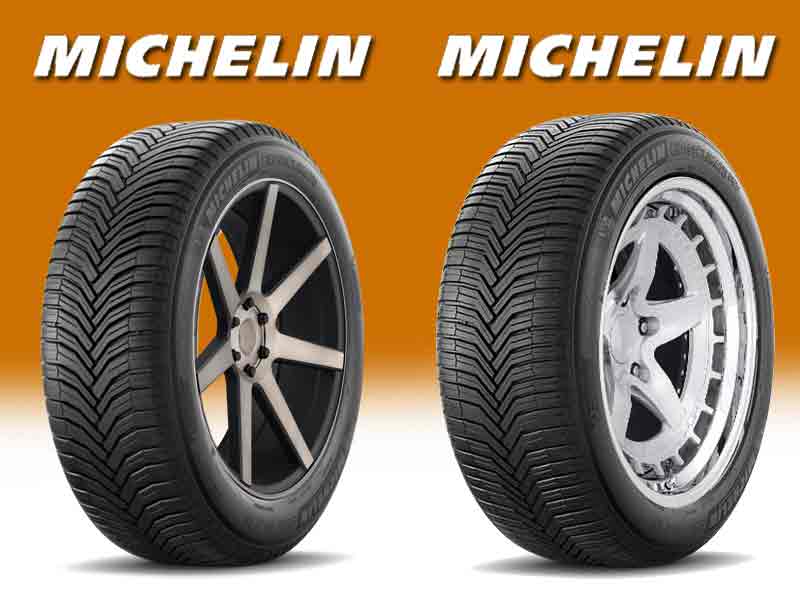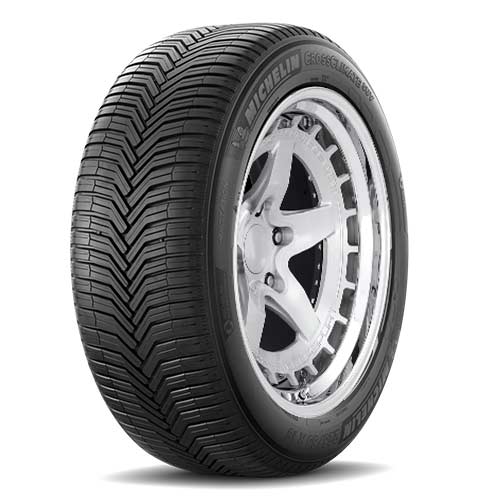When comparing all-season tire options, the Michelin CrossClimate SUV and the Michelin CrossClimate 2 often take center stage. Both promise excellent year-round performance, but which one truly excels? Let’s dive into a thorough comparison.
But first, let’s talk about where these tires should improve.

- Michelin CrossClimate 2: Its limitations lie in fluffy snow traction and shock absorption from road imperfections.
- Michelin CrossClimate SUV: This tire variant could improve on fuel efficiency, wet and dry traction, handling, and noise reduction. Its softer compound and heavier weight contribute to these shortcomings.
And so this brings us to the test scores, they achieved in our testing.
Table of Contents
Test Scores – Out of 10
| CrossClimate SUV | Crossclimate 2 | |
| Dry Traction | 7 | 8 (Better) |
| Wet Traction | 7 | 8 (Better) |
| Snow Traction | 9 (Better) | 8 |
| Ice Traction | 8 | 9 (Better) |
| Fuel Efficiency | 8 | 8 |
| Tread Life | 7 | 8 (Better) |
| Ride Comfort | 8 | 8 |
Design Comparison
The Michelin CrossClimate 2 gives you a unique and well-designed directional tread pattern.

The tire’s extended arms are interwoven, offering remarkable snow clearing and water expulsion capabilities.
These arms are divided up in to two, with the help of longitudinal slits, creating a discernible separation between the central and shoulder areas.
Speaking of shoulder lugs, they get to have thicker siping, and have wider tread voids between them.
While the central blocks are more closed up, and have a combination of straight and wave-like siping (where shoulder lugs only have rectilinear pattern of those sipes).
Moreover, these lugs also have snow vices on them, which are basically biters, especially designed for all kinds of snowy terrains.
Moving towards the Michelin CrossClimate SUV, this tire also features a directional pattern.

But still, there are a few things that are different on this tire compared to Crossclimate 2.
First off, the its lugs are thinner, meaning, they are more voided up, not only on shoulders but also on the central area.
Moreover, the tire is missing with interlocking sipes, though its siping slits all over are thicker.
Though speaking of slits, its tread is equipped with similar longitudinal slits, which separates the shoulders form the central area.
Fuel Efficiency
Fuel efficiency is significantly affected by the interaction between tires and the road, and its primarily determined by the rolling resistance, established by the friction between the tire’s tread and the road surface.
And here, although both tires aren’t that Eco-friendly, the Michelin Crossclimate 2 still takes the larger piece of the pie.
This is because the tire has a more sleek design, where its firmer rubber blend does not stick the road with as much friction.
Whereas, with a heavier weight, and a softer compound, the SUV variant experiences more lug flex, causing more energy to be used (in to the molding of the blocks, instead of rolling the tire as a whole).
But still, note that, its only on the paper, and in real world, the difference is negligible.
Durability and Treadwear
The CrossClimate SUV’s slightly higher rolling resistance also causes faster treadwear. The tire’s additional weight puts strain on each lug, increasing friction with the road and thus accelerating rubber wear, as its lugs rub against the road.
This effect is further intensified by its softer tread compound, which basically is more susceptible to burning off faster.
Though the tire’s extra weight is due to its robust structure, making it more durable than the Michelin CrossClimate 2.
It features a more solid design featuring wide steel belts, a continuous full-cover reinforcement layer, and folded belt-edge tape, which provides unmatched reliability and excellent protection against punctures.
Winter Performance
In terms of winter traction, the CrossClimate 2 outperforms many, including its SUV variant.
Its extended lugs efficiently move slush and snow, more efficiently, providing better forward momentum compared to the Crossclimate SUV, despite both tires have 3 peak mountain snowflake (3PMSF) ratings, and a directional tread pattern.
Note: It’s important to note that the 3PMSF rating mainly measures acceleration abilities, and its not a measure of braking or handling capability of a tire, which is a common misunderstanding. A tire having this rating simply does 10% better than an average all-season tire (not having that rating of course). Also, tires with this rating, aren’t as capable as winter tires.
Though there’s one area where Crossclimate SUV is superior, and that is fluffy snow traction.
When it comes to powdery snow, or slightly thicker snowy terrains, the SUV variant is able to offer a better snow trapping abilities, creating greater snow-to-snow contact – an ideal condition as snowflakes stick to each other, better than to tire rubber.
And yes, the tire’s softer (more) thermally adaptive rubber also ensures better flexibility in colder temperatures too, comparatively.
Wet Traction
In wet conditions, the CrossClimate 2 performs better than the CrossClimate SUV, due to its specific tread design and greater in number siping.
These sipes, or small cuts in the tread, effectively remove water particles, enabling better grip. They basically suck up the water particles in their slits, allowing the tread’s rubber to be able to contact the relatively dried up surface with greater friction.
With the combination of interlocking central siping, and the multi-angled shoulder slits, the Crossclimate 2 gets to offer better overall handling times and braking efficacy.
(Braking measures directional grip, while lap times calculate handling).
Furthermore, hydroplaning resistance, is also a crucial part of overall wet performance and here both tires do same.
Their V-shaped, directional lug structure excel equally at moving water away from the tread, allowing for similar float speeds in both curved and straight aqua tests.
Dry Grip And Handling
First things first, understand that when a tire goes straight, it puts most of its weight on the middle tread. And when it turns, this weight moves to the edges because of inertia.
So central area defines dry/directional grip, and shoulders tell about handling.
And in both these scenarios, the Crossclimate 2 does better, where it offered 5 feet shorter (average), braking distances, and a 2 second faster lap times (again on average).
The tire basically has a more closed up central section, offering superior straight line grip, and it’s lighter weight allows for superior handling feedback, when the tire corners.
And hes, its rounded contact patch also helps, shift this weight smoothly from the center to the edges, which makes steering better.
Tread Noise
Tire noise is primarily due to air interaction with the tread.
What’s happening here is that, the air particles typically enter through shoulder gaps, hitting the surrounding walls, where the impact is what’s producing noise.
So it makes sense why the Michelin Crossclimate 2 is taking the lead here, and the SUV variant is lacking with its larger tread voids, allowing more air particles to enter.
Moreover, the Crossclimate SUV’s softer rubber also tends to reflect more air particles, creating increased in-groove resonance (its basically the echoing of the noise waves, within the tread).
On-Road Vibrations
Ride quality is also related to the tire’s ability to absorb road imperfections.
And so here, the softer compound of the Michelin Crossclimate SUV shines.
Simply put it’s rubber, made of a higher silica content and softer inner cap ply absorb road shocks more effectively, compared to its counterpart.
So the tire might not be so great when it comes to handling stability (with its greater weight), it still excels overall in case of impact comfort performance.
To Conclude
Michelin CrossClimate 2 excels in:
- Fuel Efficiency: The tire’s sleek design and firmer rubber blend create less road friction, making it more fuel-efficient compared to its SUV variant.
- Wet Traction: Its specific tread design and numerous siping effectively remove water particles, offering superior handling times and braking efficacy. Both tires perform similarly in hydroplaning resistance.
- Dry Grip and Handling: The CrossClimate 2 offers better dry grip due to its more closed central section. It also provides better handling feedback during cornering due to its lighter weight and rounded contact patch.
- Tread Noise: It offers a quieter ride due to smaller tread voids which restrict air particle entry, and therefore noise production.
Michelin CrossClimate SUV excels in:
- Durability: Its extra weight, due to its robust structure featuring wide steel belts, a continuous full-cover reinforcement layer, and folded belt-edge tape, makes it highly durable and puncture-resistant.
- Fluffy Snow Traction: In snowy terrains, especially powdery or thicker ones, the SUV variant performs better due to its superior snow trapping abilities, creating greater snow-to-snow contact.
- On-Road Vibrations: Its softer compound made of higher silica content and softer inner cap ply effectively absorbs road shocks, providing a more comfortable ride.